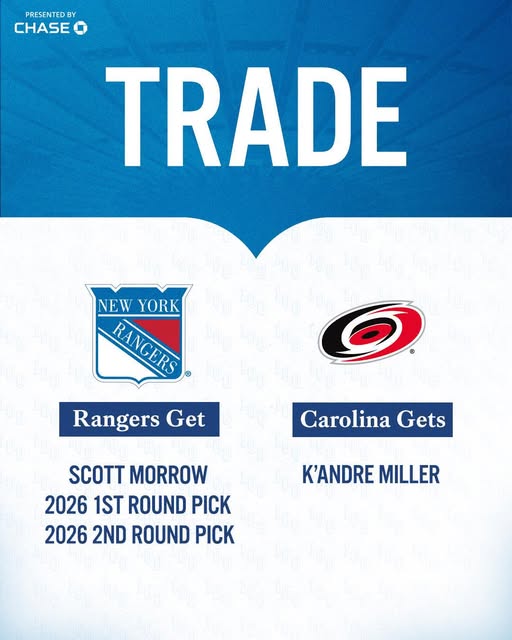The New York Rangers have been making waves in the NHL with their recent trade activities, drawing attention from fans and analysts alike. Trades in professional sports, especially in the NHL, are often complex transactions that involve a careful balancing act between player potential, salary cap considerations, and team needs. The New York Rangers’ latest trade moves reflect a strategic approach aimed at strengthening their roster for the upcoming season and beyond.
At the heart of any significant trade are the players and assets exchanged. For the Rangers, recent trades have involved a mixture of seasoned veterans and promising young talents. This blend indicates the team’s desire to not only remain competitive in the short term but also to build a sustainable core for the future. When the Rangers make a trade, it’s clear that the front office is weighing immediate roster improvements alongside the long-term impact of acquiring draft picks or prospects.
One of the critical details of the latest trades centers around the Rangers acquiring players who can fill specific roles on the ice. In recent years, the team has struggled with depth in certain positions, particularly on defense and in scoring depth beyond their top lines. Addressing these weaknesses through trades shows a calculated plan to improve the overall balance of the team. For example, the Rangers have sought players known for their defensive reliability, physicality, and ability to contribute offensively when needed. By targeting such players, the team hopes to shore up its defensive zone and provide more secondary scoring options.
The salary cap also plays a significant role in the Rangers’ trade strategy. Like every NHL team, the Rangers operate under a strict salary cap, which limits how much they can spend on player salaries. This constraint requires teams to be creative and strategic with trades. The Rangers have demonstrated savvy in this area, sometimes acquiring players with expiring contracts or trading away salary in exchange for valuable assets. Managing the salary cap effectively ensures the team can maintain flexibility for future moves and avoid being hamstrung financially.
Draft picks are another vital component of the Rangers’ trade dealings. Future draft picks offer the team a chance to select young players who might develop into key contributors down the line. The Rangers have been careful in how they trade these picks, understanding the value they hold in building a sustainable contender. While they have been willing to part with some picks to acquire immediate help, they also ensure that they retain enough draft capital to continue replenishing their prospect pool. This balance between present and future assets is a hallmark of a well-run organization.
When breaking down the specifics of the most recent trade, it’s essential to look at who the Rangers acquired and who they parted ways with. Each player involved carries a unique profile, and understanding their roles and potential impact provides insight into the team’s strategy. Some acquired players bring veteran experience, which is invaluable during the grueling NHL season and playoff runs. Others are younger players or prospects who could develop into significant contributors with proper coaching and development.
The team also considers the chemistry and fit of new players within the existing roster. Trades are not just about individual talent; they also affect team dynamics. The Rangers have prioritized acquiring players who can integrate smoothly into their system, both on and off the ice. This attention to team culture and locker room chemistry is crucial for sustained success, as hockey is a highly collaborative and fast-paced sport where players must work seamlessly together.
Analyzing the trade details also involves examining the conditions or clauses attached to the trade, such as conditional draft picks or salary retention. The Rangers have occasionally included conditions in their trades, which hinge on future performance or player re-signings. These conditions provide a layer of protection or potential upside for the team, making trades less risky. For example, a draft pick might be upgraded if a player reaches a particular milestone, or salary might be retained partially to facilitate the trade.
The timing of the trade is another aspect worth noting. Trades around the NHL trade deadline tend to be more aggressive and impactful, as teams push for playoff contention or look to rebuild. The Rangers’ recent moves suggest they are positioning themselves to be competitive in the short term while laying the groundwork for long-term success. This dual focus shows a front office that understands the ebb and flow of a competitive NHL season and the importance of seizing opportunities as they arise.
Fan reactions to the trades have been mixed but generally optimistic. Some fans are excited about the new players’ potential to elevate the team’s performance, while others are cautious about losing beloved prospects or future draft picks. The Rangers’ management has been transparent in communicating the rationale behind the trades, which helps maintain trust and support from the fanbase. Engaging with fans and providing clarity about team decisions is an essential part of building a loyal and passionate community around the franchise.
The impact of the trades will ultimately be measured on the ice. New players will need to adjust quickly to the Rangers’ style of play and contribute to team success. Coaches will integrate these players into various lines and special teams units, trying to maximize their strengths. The Rangers’ coaching staff plays a crucial role in helping new additions find their roles and thrive within the team system. Their ability to do so could be the difference between a trade being a resounding success or falling short of expectations.
In a broader context, these trade moves reflect the evolving landscape of the NHL. Teams are constantly adapting to new challenges, including changes in salary cap, player movement, and competitive balance. The Rangers’ approach highlights the importance of flexibility and foresight in modern hockey management. By carefully navigating trades, managing finances, and focusing on player development, the Rangers aim to maintain their position as a strong contender in the Eastern Conference.
Looking ahead, the Rangers will continue to monitor their roster and the league landscape for additional opportunities to improve. Trades are just one piece of a larger puzzle that includes drafting, player development, free agency, and internal growth. The recent trades show the team’s commitment to remaining proactive rather than reactive. This mindset will be critical as the Rangers face stiff competition from other talented teams in their division and conference.
In summary, the New York Rangers’ recent trade details reveal a thoughtful and strategic effort to bolster their team both immediately and in the future. By acquiring players who address specific needs, managing salary cap considerations, and carefully balancing draft picks and prospects, the Rangers are building a competitive and sustainable roster. The success of these moves will unfold over the coming season, but the foundation laid by these trades demonstrates a clear vision for the team’s direction. Fans and analysts alike will be watching closely as the Rangers integrate their new players and continue their pursuit of Stanley Cup glory.



